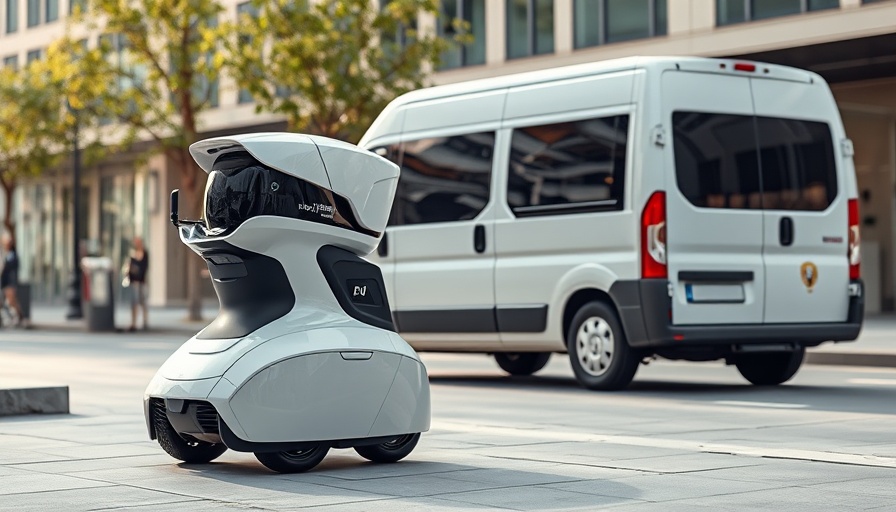
The Revolution of Last-Mile Delivery: Rivr and Veho's Innovative Approach
For years, the challenge of last-mile delivery has plagued urban logistics, often causing delays, inefficiencies, and customer dissatisfaction. A new pilot program in Austin, Texas, is taking a creative approach to tackle this common problem: the uniquely designed dog-like robots from Rivr paired with Veho's delivery vans. With this collaboration, the delivery process aims to transform the journey from the curb to the customer’s doorstep.
How the Robot Delivery System Works
In a move that could redefine urban logistics, Rivr’s robots—aptly described by CEO Marko Bjelonic as “a dog on roller skates”—are set to facilitate the last 100 yards of package delivery. The system will initially deploy just one robot in highly monitored settings, running for five to six hours daily over several weeks. As Bjelonic noted, these robotic companions are designed to handle tasks that are straightforward for humans but intricate for machines. Moreover, this test run is a vital step toward identifying practical uses for robotic technologies in overcoming last-mile challenges.
The Science Behind Robotics in Delivery
According to Bjelonic, while software-based models like ChatGPT benefit from extensive internet data, robotics lacks a similar dataset. By developing a practical use case like last-mile delivery, Rivr can begin to gather the information needed to enhance its robot's intelligence. Interestingly, this initiative also addresses the data barrier that many in the autonomous technology space are wrestling with.
The Impact on Urban Logistics
Veho, known for its delivery operations serving well-known brands like Sephora and HelloFresh across 50 U.S. markets, views this partnership as an opportunity to explore automation in last-mile delivery. According to Bjelonic, utilizing Rivr's robots can broaden operational capacity, especially in suburban and urban environments where density presents significant logistical hurdles. The aim is clear: not only alleviate the workload on delivery drivers but also optimize delivery efficiency.
Why Austin is the Testing Ground
Austin's urban landscape makes it the perfect testing ground for pioneering delivery solutions. With a mix of residential and commercial areas, a successful pilot could pave the way for technology-driven solutions tailored to the needs of other metropolitan locations. The proximity of Rivr's operations also minimizes key logistical challenges, positioning this pilot as a foundational step toward broader implementations of robotic delivery solutions.
The Future of Robotics in Delivery
The future appears promising, as more municipalities turn their attention to integrating automation into daily operations. As technology continues to evolve, the idea of robots effectively sharing the responsibility for delivery logistics will become increasingly viable. The ultimate goal remains to develop systems that not only meet consumer expectations but also address a range of logistics challenges effectively.
Overcoming Challenges in the Robotics Space
While the pilot in Austin marks a significant leap forward, the journey to robotic delivery won't be without hurdles. Safety concerns, public perceptions, and regulatory approvals will require careful navigation. To enhance public acceptance and trust, Rivr has stated that a human will accompany the robots during the testing period, ensuring that safety standards are upheld and any delivery issues can be promptly addressed.
What This Means for Consumers
For consumers, this initiative could herald a new era of improved delivery experiences. As Rivr and Veho refine their processes, customers can anticipate faster deliveries, reduced wait times, and a more seamless overall interaction with package delivery services. Should this pilot prove successful, we can expect further innovations in urban logistics aimed at embracing technological advancements while streamlining operations.
Concluding Thoughts: Preparing for the Future of Deliveries
This partnership between Rivr and Veho presents a noteworthy step forward in the evolution of last-mile delivery solutions. As the demand for more efficient and timely delivery services escalates, advancements in robotics and automation will likely play a critical role in shaping the logistics landscape. Stay tuned to see how this pilot program unfolds in Austin and what it might mean for deliveries in your area!
 Add Row
Add Row  Add
Add 



Write A Comment